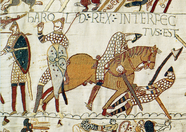A RATIONALE FOR COMICS
When it comes to comics and the broader tradition of visual narrative, it is incumbent upon educators to teach students about the genre and its history. If we talk to students about how poetry developed from an oral tradition, or about the resurgence of the drama during the middle ages, we must also talk to them about how sequential art has evolved over time. We must treat the genre with the same degree of seriousness with which treat other genres, because not doing so would be to suggest that there is something nobler or far more worthy of our consideration in poetry or in drama than in visual narrative.
That, however, is rubbish.
Great works of literature are great because they merit such distinction--not because they happen to be of one particular genre and not another. We don't look down our nose at War and Peace because it's a novel and not poetry. We don't think less of King's "Letter from Birmingham Jail" because it's "only a letter."
Visual narrative is a genre worthy of study, both for ourselves and for our students. This website is dedicated to proving that.
That, however, is rubbish.
Great works of literature are great because they merit such distinction--not because they happen to be of one particular genre and not another. We don't look down our nose at War and Peace because it's a novel and not poetry. We don't think less of King's "Letter from Birmingham Jail" because it's "only a letter."
Visual narrative is a genre worthy of study, both for ourselves and for our students. This website is dedicated to proving that.




